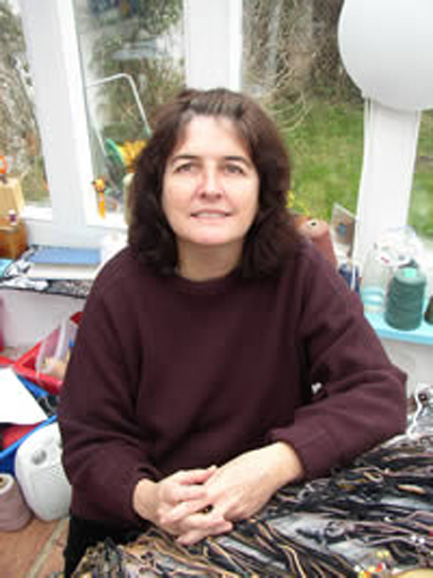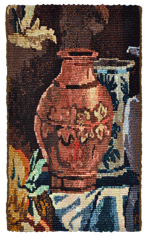
Previous artist Next artist
Like many girls, I learned basic textile techniques from my family and friends in my youth. Textiles became a language through which I could express myself creatively. Later, I was attracted to the contemporary art form of woven tapestry, through seeing exhibitions, and images from the Lausanne Biennales. Large-scale, hung in art galleries, and obviously of high value, tapestry appeared to me as just another fine-art medium, communicating its messages with seriousness and dignity. At the time it was also largely being made by women, individual artist-makers, so perhaps I saw a possible arena in which I could express myself.
When I had the opportunity to learn woven tapestry as a Post-Graduate art student, I saw it as a medium through which to communicate my ideas, the same as drawing, painting or sculpture. Thus I have always strongly identified with the idea of the tapestry weaver as an individual artist. At the same time, I am also familiar with, and inspired by, the work of contemporary ateliers where the works of ‘fine’ artists in other media are transformed by skilled weavers into powerful tapestries. What really matters to me is whether the work is interesting and meaningful; whether it communicates something to me. The technical source of the work is less important.
Before I decided to become an artist, I was exposed to Medieval tapestry weaving, studying Art History at university. The later European tradition, with its prosperous ateliers employing skilled artisans to produce sumptuous wall coverings for kings and princes, and the increasing separation between designer and weaver, wasn’t something I knew very much about. To me, the works of that period were just part of the time-line of historic textiles, along with artefacts like nomadic kilim rugs or Peruvian Nazca tapestries.
In more recent times, I have become much more aware of this important aspect of tapestry history, seeing some beautiful examples and trying to learn more about it. It has been very enjoyable to take my inquiries further on this occasion, being invited to focus on a major Brussels tapestry. For this project, I chose to reinterpret my selected fragment of ‘Mercury Hands over the Infant Bacchus to the Nymphs’ using my own self-evolved technique. I tried to analyse and explore the use of colour and form in the original work. In places I exaggerated or changed what I found in order to make an autonomous composition from the small section of the larger whole. In the process I have made something quite different from my usual work. Being given access to this historic source was an opportunity to think differently, create some new rules for myself and find solutions from outside my ‘comfort-zone’. It was a pleasure and honour to spend time learning a little bit from the master-weavers of earlier times.
